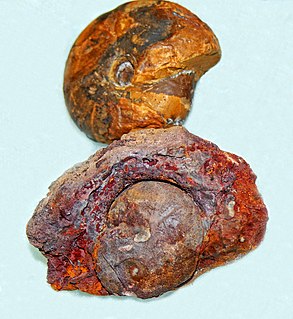| Ephippioceratidae | |
|---|---|
| Scientific classification | |
| Kingdom: | Animalia |
| Phylum: | Mollusca |
| Class: | Cephalopoda |
| Subclass: | Nautiloidea |
| Order: | Nautilida |
| Superfamily: | † Clydonautiloidea |
| Family: | †Ephippioceratidae Miller & Youngquist, 1949 |
Ephippioceratidae is a family of clydonatilacean nautilids with shells as in the Liroceratidae but with sutures that have deep ventral and dorsal saddles. This group, which contains two genera, Ephippioceras and Megaglossoceras, has a range from the Mississippian to the Lower Permian.
The Clydonautiloidea are a superfamily within the nautiloid order Nautilida characterized by smooth, generally globular, shells with nearly straight sutures, in early forms, but developing highly differentiated sutures in some later forms. Where known, the siphuncle tends to be central to subcentral.

The Nautilida constitute a large and diverse order of generally coiled nautiloid cephalopods that began in the mid Paleozoic and continues to the present with a single family, the Nautilidae which includes two genera, Nautilus and Allonautilus, with six species. All told, between 22 and 34 families and 165 to 184 genera have been recognised, making this the largest order of the subclass Nautiloidea.
Liroceratidae is an extinct family of nautilids, shelled marine molluscs, belonging to the Clydonautiloidea, consisting of generally smooth, involute, nautiliconic forms with a small umbilicus. The whorl section is usually depressed and broadly rounded, the suture only slightly sinuous, and the siphuncle usually more or less central.
Ephippioceras, which has the full range of the family, has a broad, narrowly peaked ( V-shaped) ventral saddle and may have been derived from Liroceras early in the Mississippian. Megaglossoceras from the Pennsylvanian of North America, with its large, broadly arched, tongue-like ventral saddle is an obvious offshoot of Ephippioceras. Both are subglobular and involute with a reniform whorl section. Ephippioceras has been found in North America, Europe, and China.
Liroceras is a genus of nautiloid cephalopod. It is the type genus of the clydonautiliacean family, Liroceratidae, and is characterized by a rapidly expanding, subglobular, nautiliconic shell with a reniform whorl section, small umbilicus, essentially straight sutures, and a siphuncle with a variable but not marginal position.
The Pennsylvanian is, in the ICS geologic timescale, the younger of two subperiods of the Carboniferous Period. It lasted from roughly 323.2 million years ago to 298.9 million years ago Ma. As with most other geochronologic units, the rock beds that define the Pennsylvanian are well identified, but the exact date of the start and end are uncertain by a few hundred thousand years. The Pennsylvanian is named after the U.S. state of Pennsylvania, where the coal-productive beds of this age are widespread.


